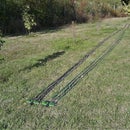Introduction: DIY Nut Driver for 3.5mm Audio Jack Knurled Nuts
Knurled nuts seem to be intended for just finger-tightening, but a tool can make more uniform tightness. Unfortunately, for some reason a proper tool is very scarce these days, or expensive if you can even find one for sale. I made my own by modifying a nut driver. With this driver tool it is easy to tighten many nuts (such as I did on a synthesizer kit) to uniform, correct tightness.
Supplies
TOOLS:
hand drill, or drill press (recommended)
vice attached to bench
portable table vice
right angle measurement tool
6mm or 15/64" drill bit
3.2mm or 1/8" drill bit
large flat file
triangular needle file
SUPPLIES:
5mm or 3/16" nut driver (to modify)
1/8" plastic tubing https://www.amazon.com/Rod-Tube-Assortment-7-Evergreen/dp/B0006O5FAK/
Step 1:
Basic Dimensions
A 5mm or 3/16" nut driver hex opening is 5mm (0.187") by approximately 5.4mm (0.21"). The threaded shank width of a 3.5mm audio jack is 5.5mm (0.23"). A 6mm or 15/64" drill bit will create a round opening in the nut driver just right for the shank on the jack.
Any 5mm or 3/16" nut driver should work but I used a 3/16" nut driver from a Harbor Freight 7-piece set that cost $9.99. I liked that because the metal is soft enough to easily drill and hand-file, whereas a more quality nut driver might have harder steel.
The basic tools needed are a drill, a bench vise, 6mm or 15/64" and 3.2mm or 1/8 inch drill bits, and a good flat file. I recommend using a drill press, with the nut driver held vertically in a portable table vice below it, to drill straight holes. Also, if you have a needle file set with a triangular file, it can more accurately cut the inside corner of a 90 degree angle where needed.
Step 2:
Procedure
1. Hold the nut driver in a vice and carefully drill out the hex-shaped inside to be round using the 5mm or 15/64 inch bit, down to a depth of about 5mm or 3/16" from the rim. Verify that the threaded shank of the jack slips freely down into the opening without bottoming out.
2. Put the nut driver in a secure bench vice and hold a 3.2mm or 1/8" drill bit in the opening of the nut driver as a spacer to block the file from cutting the rim too close to the center of the hole. Carefully file one side of the driver rim down 1 millimeter. Then turn the nut driver 180 degrees in the vice and hold the 3.2mm or 1/8" drill bit to file the other side down to create the two little nubs.
The nubs should be as wide as you can make them and still fit into the slots on the knurled nut. They should also be as vertical as possible to get a good bite in the slots. If you overcut while making the nubs the first time, you still have a second chance and you can file them off and try once more since you only removed 1mm of the rim the first time.
Step 3:
An additional, optional modification is to add a guide into the nut driver to simulate a plug going into the jack to center the nut driver. Without this part, the nut driver will still center on the shank after screwing the knurled nut on, but the added guide centers the tool better.
Drill a hole further into the center of the nut driver a few millimeters deep using a 3mm or 7/64" drill bit. Obtain a piece of 1/8" plastic tubing and cut it to a length of about 13mm or 0.5". Taper one end slightly so it starts to fit in the new hole and gently tap it in with a small hammer. If the plastic piece ever breaks off in the hole, you can easily drill the remaining plastic out of the hole and insert a new piece.












